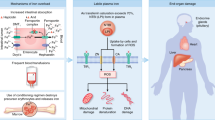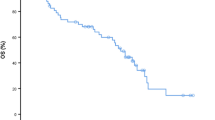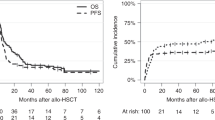Abstract
Iron overload contributes to increased transplant-related mortality, and serum ferritin is typically used to detect iron overload. Other iron parameters have received limited attention. We studied serum ferritin, transferrin, transferrin saturation, iron, soluble transferrin receptor (sTfR) and C-reactive protein (CRP) levels in 230 consecutive patients undergoing myeloablative allo-SCT. All iron parameters were significantly associated with survival. When analyzed individually, both sTfR and transferrin saturation were superior in prognostic power to ferritin (areas under the curve in receiver operating characteristic analysis: 0.670, 0.715, and 0.657, respectively). A combination of ferritin and transferrin saturation had the highest prognostic power: Patients with ferritin below the 30th percentile (<802 ng/mL) showed excellent survival (70±6% at 5 years), while transferrin saturation above the 80th percentile (⩾69%) pointed to a high risk of transplant failure (5-year survival 5±5%). The remaining patients showed an intermediate outcome (5-year survival 52±5%). The prognostic impact of iron parameters was independent of other factors such as stage, conditioning regimen and CRP level, and operated similarly across diseases. Iron overload strongly influenced the outcome of allo-SCT. Low pre-transplant ferritin levels indicate a population at low risk, high transferrin saturations and a subgroup of patients with very poor outcome.
This is a preview of subscription content, access via your institution
Access options
Subscribe to this journal
Receive 12 print issues and online access
$259.00 per year
only $21.58 per issue
Buy this article
- Purchase on Springer Link
- Instant access to full article PDF
Prices may be subject to local taxes which are calculated during checkout



Similar content being viewed by others
References
Lichtman SM, Attivissimo L, Goldman IS, Schuster MW, Buchbinder A . Secondary hemochromatosis as a long-term complication of the treatment of hematologic malignancies. Am J Hematol 1999; 61: 262–264.
Majhail NS, Lazarus HM, Burns LJ . Iron overload in hematopoietic cell transplantation. Bone Marrow Transplant 2008; 41: 997–1003.
Carmine TC, Evans P, Bruchelt G, Evans R, Handgretinger R, Niethammer D et al. Presence of iron catalytic for free radical reactions in patients undergoing chemotherapy: implications for therapeutic management. Cancer Lett 1995; 94: 219–226.
Halliwell B, Gutteridge JM, Cross CE . Free radicals, antioxidants, and human disease: where are we now? J Lab Clin Med 1992; 119: 598–620.
Strasser SI, Kowdley KV, Sale GE, McDonald GB . Iron overload in bone marrow transplant recipients. Bone Marrow Transplant 1998; 22: 167–173.
Kanda J, Mizumoto C, Ichinohe T, Kawabata H, Saito T, Yamashita K et al. Pretransplant serum ferritin and C-reactive protein as predictive factors for early bacterial infection after allogeneic hematopoietic cell transplantation. Bone Marrow Transplant 2011; 46: 208–216.
Beerenhout C, Bekers O, Kooman JP, van der Sande FM, Leunissen KM . A comparison between the soluble transferrin receptor, transferrin saturation and serum ferritin as markers of iron state in hemodialysis patients. Nephron 2002; 92: 32–35.
R’Zik S, Beguin Y . Serum soluble transferrin receptor concentration is an accurate estimate of the mass of tissue receptors. Exp Hematol 2001; 29: 677–685.
Gratwohl A, Stern M, Brand R, Apperley J, Baldomero H, de Witte T et al. Risk score for outcome after allogeneic hematopoietic stem cell transplantation: a retrospective analysis. Cancer 2009; 115: 4715–4726.
Centis F, Delfini C, Agostinelli F, Barbanti I, Annibali M, Lucarelli G . Correlation between soluble transferrin receptor and serum ferritin levels following bone marrow transplantation for thalassemia. Eur J Haematol 1995; 54: 329–333.
Baynes R, Bezwoda W, Bothwell T, Khan Q, Mansoor N . The non-immune inflammatory response: serial changes in plasma iron, iron-binding capacity, lactoferrin, ferritin and C-reactive protein. Scand J Clin Lab Invest 1986; 46: 695–704.
Altes A, Remacha AF, Sureda A, Martino R, Briones J, Canals C et al. Iron overload might increase transplant-related mortality in haematopoietic stem cell transplantation. Bone Marrow Transplant 2002; 29: 987–989.
Armand P, Kim HT, Cutler CS, Ho VT, Koreth J, Alyea EP et al. Prognostic impact of elevated pretransplantation serum ferritin in patients undergoing myeloablative stem cell transplantation. Blood 2007; 109: 4586–4588.
Sahlstedt L, Ebeling F, von Bonsdorff L, Parkkinen J, Ruutu T . Non-transferrin-bound iron during allogeneic stem cell transplantation. Br J Haematol 2001; 113: 836–838.
Pullarkat V . Objectives of iron chelation therapy in myelodysplastic syndromes: more than meets the eye? Blood 2009; 114: 5251–5255.
Author information
Authors and Affiliations
Corresponding author
Ethics declarations
Competing interests
The authors declare no conflict of interest.
Rights and permissions
About this article
Cite this article
Bazuave, G., Buser, A., Gerull, S. et al. Prognostic impact of iron parameters in patients undergoing allo-SCT. Bone Marrow Transplant 47, 60–64 (2012). https://doi.org/10.1038/bmt.2011.13
Received:
Revised:
Accepted:
Published:
Issue Date:
DOI: https://doi.org/10.1038/bmt.2011.13
Keywords
This article is cited by
-
Post-transplant ferritin level predicts outcomes after allogeneic hematopoietic stem cell transplant, independent from pre-transplant ferritin level
Annals of Hematology (2021)
-
Iron Metabolism: An Emerging Therapeutic Target in Critical Illness
Critical Care (2019)
-
Iron overload in myelodysplastic syndromes (MDS)
International Journal of Hematology (2018)
-
Pre-transplant ferritin, albumin and haemoglobin are predictive of survival outcome independent of disease risk index following allogeneic stem cell transplantation
Bone Marrow Transplantation (2017)
-
Prognostic pre-transplant factors in myelodysplastic syndromes primarily treated by high dose allogeneic hematopoietic stem cell transplantation: a retrospective study of the MDS subcommittee of the CMWP of the EBMT
Annals of Hematology (2016)



